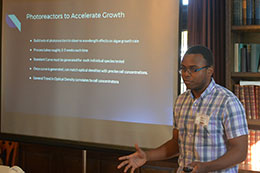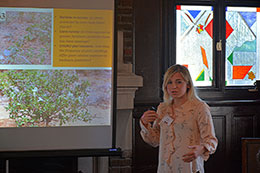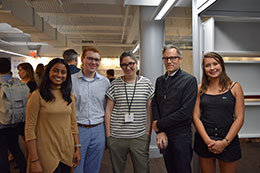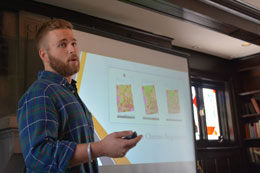Drones, Thorns and New Orleans: PEI’s Summer of Learning Symposium features breadth of undergrad research
Drones in Africa, algal biofuel and the necessity of thorns. These topics and more constituted the varied research projects of 88 Princeton University undergraduates who presented the results of their summer-long internships during the Princeton Environmental Institute’s 2017 Summer of Learning Symposium Oct. 6 at the Campus Club.
Students participating in PEI’s internship program collaborated with Princeton faculty, researchers from other institutions, government agencies, and nongovernmental organizations and community groups. Their projects focused on global environmental challenges in the areas of policy and resilience, biodiversity and conservation, alternative energy, climate and oceans, and water, soil and human health. Student interns based in different areas of the United States and in 12 countries tackled these issues from scientific, technical, policy and human dimensions through research, outreach, policy analysis and other practical experiences.
The photos and excerpts below provide a snapshot of the research featured at the symposium.
“Promoting Algae Growth with Photoreactors”


Eseiwi Aifuwa ’19, a chemical and biological engineering major, constructed vessels known as photoreactors that could be used for the large-scale cultivation of algae, which scientists are exploring as a potential source of biofuel. “Before you can worry about the actual engineering aspect, you have to make sure that growing algae itself is viable,” said Aifuwa, who was advised by José Avalos, assistant professor of chemical and biological engineering. Aifuwa built his photoreactors from large jars equipped with light-emitting diodes (LEDs) and timers on an 18-hour cycle. He tested the effectiveness of red versus green light in growing algae and found that red light resulted in the most rapid growth. Aifuwa was able to get growth time down to 2-3 weeks, but a growth period of less than one week is needed for algae to be a feasible energy source, he said. Aifuwa plans to continue the project for his junior paper and possibly his senior thesis, and also may patent his design. When asked what the project taught him about research, he said, “Caution. Tiny bits of bacteria getting into one of these jars ruins a three-week experiment.”
“Effect of El Niño Rainfall Patterns on the Population Dynamics of a Tropical Forest Bird”


Luke Carabbia ’19 and Zachariah Smart ’20, both ecology and evolutionary biology majors, worked with Christina Riehl, assistant professor of ecology and evolutionary biology, studying the bird species greater ani on Barro Colorado Island, Panama. A member of the cuckoo family, the bird is known for its communal nests in which females share feeding and incubation duties. But females also will surreptitiously push out other adults’ eggs to make room for their own. “It raises all these interesting questions about natural selection,” Smart said. Carabbia and Smart examined if the vigor with which nestlings call for food, or “gape,” influences how often they are fed and, thus, their survival. The pair measured and marked individual nestlings for easy identification and monitoring. They then set up cameras at multiple nests to record feedings; they collected more than 400 hours of footage. Carabbia and Smart worked with Riehl as part of her PEI Water and the Environment Grand Challenge project, “Effect of El Niño Rainfall Patterns on the Population Dynamics of a Tropical Forest Bird.”
“Impacts of Sea-level Rise on the Release of Halomethanes from Coastal Systems”


SiSi Peng ’19 and Marah Sakkal ’20 used a benchtop X-ray fluorescence (XRF) machine to explore the interaction between organic elements in inland soils and salt water brought on by sea-level rise. Their work contributed to an ongoing project in the lab of their adviser, Satish Myneni, professor of geosciences. Salt water contains bromide and ions that react with organic carbon to create halomethane, a compound that contributes to the destruction of stratospheric ozone as well as to global warming. Peng, a geosciences major, studied the environmental factors that influence bromide-soil reactions. She compared dry sandy soil from the New Jersey Pine Barrens to saturated soil from freshwater marshes in South Carolina. Peng added increasing amounts of salt water, sulfate and bicarbonate to the soil to analyze how they affected levels of bromide and organochlorine. Sakkal conducted a soil profile analysis in order to better understand how the chemical reactions are influenced by soil type. She compared the composition of a soil core she obtained from the Pine Barrens (temperate) to two cores from Costa Rica (tropical). She found that both soils were organic-carbon rich at the top, but that the Pine Barrens soil was silicate at the bottom while the Costa Rican soil was iron-rich. Peng and Sakkal plan to continue their work with additional soil types.
“Plant Defenses in an African Savanna”


Anna Marsh ’20, an art and architecture major, worked at the Mpala Research Centre in Kenya to study how exposure to herbivores and other plants influences plant defense and reproduction. Her advisers were Rob Pringle, assistant professor of ecology and evolutionary biology, and Tyler Coverdale, a graduate student in Pringle’s group who studies plant defenses. In one part of her research, Marsh studied the density of thorn growth in the plant genus Baleria and found that plants protected by thick vegetation produced fewer thorns. Thorn growth is energy intensive, Marsh said: “This is a standard evolutionary principle that allows plants to use their energy more effectively.” She also found that more protected trees host less liana, a woody vine that can blanket treetops, and produce higher seed counts. Related to her concentration in architecture, Marsh’s internship got her thinking about energy expenditure on structural elements that are shielded by their surroundings: “The natural world is very intelligent and I think it’s important to think about nature when building.”
“The Batture Ritual: An Intimate Look at the Macro- and Micro-Economies of the Mississippi River”


“My project starts with a tree,” said Angélica Vielma ’18, who spent her summer in New Orleans working as a production assistant and research intern on a documentary about climate change, human activity and the fragile economy of the Lower Mississippi River. Situated on a batture — the land between a low-stage river and a levee — the tree was a daily stop for Vielma and her adviser, Jeffrey Whetstone, professor of visual arts in the Lewis Center for the Arts, who is making the documentary as part of his PEI Urban Grand Challenges project, “Flow: Living with the Mississippi.” “One of the biggest things about the Mississippi River and New Orleans is how affected they are by climate change,” Vielma said. “It’s not sustainable — it’s a harsh reality and these cities are not going to remain, in my opinion.” With permission from the Port of New Orleans, the film crew worked every day from 9 p.m. to 3 a.m. or 3 a.m. to noon filming the people, places and commerce on and along the river. “My summer was not what I expected it to be,” Vielma said. “I was pleasantly surprised by my experiences and the creative opportunity to transfer those into art. I also got to think about how scientific data can be transformed into art. The intersection where art and science meet is where information flourishes.”
“Design Research, Collaboration and Education for Regional Planning and Resilience”


Art and architecture majors Noshin Khan ’19 and Matthew Maldonado ’18 and Felicia Jiang ’18 and Amber Lin ’19, both majors in civil and environmental engineering, worked with the New York-based firm LTL Architects to design a series of exhibitions intended to increase public knowledge and engagement in the final design proposals for the Regional Plan Association’s (RPA) upcoming fourth plan for the future development of the New York area. Advised by Paul Lewis and Guy Nordenson, professors of architecture, the team first created a model for a proposed design for Fort Tilden, Queens, that was displayed at a June 27 private exhibition at New York University. For a larger exhibition on Fort Tilden that ran Aug. 4-Sept. 17, the Princeton team endeavored to make the RPA proposed plans understandable, interactive and personal. They created a large map on which the public could indicate where in New York City they live. For children, they created Lego models of the four corridors covered by the RPA plan: the Triboro, the Bight, the Inner Ring and the Highlands. The team constructed the space for a third exhibition at the Museum of Modern Art that also ran Aug. 4-Sept. 17.
“Drones, Drones Everywhere: New Tools for High-Definition Rangeland Assessment”


Daniel Petticord ’19, ecology and evolutionary biology major, worked to troubleshoot open-source software that identifies large-scale topography via drone. This technology could capture landscape-sized changes in vegetation due to grazing, changes in precipitation or human activity that could be used in studying ecosystem health and sustainable land use, he said: “It really allows for large-scale data generation with no risk to a person,” he said. Topographical software is programmed to identify landform types in a photograph based on pixel concentration — a high number of pixels indicates trees, for instance. While effective, however, software can be thrown off by lighting, the time of day, certain species and other ambiguities. Working at the Mpala Research Centre in Kenya, Petticord — who was advised by Daniel Rubenstein, the Class of 1877 Professor of Zoology — used a trial-and-error approach to make the software more sensitive to small but important landscape distinctions on the African savanna, such as the difference between trees and stands of grass. The experience gave him a thirst for field research, Petticord said. “I walked away from this summer thinking this is really something I could devote my life to,” he said. “I had thought I was committed to this, and now I know.”




